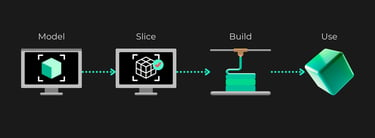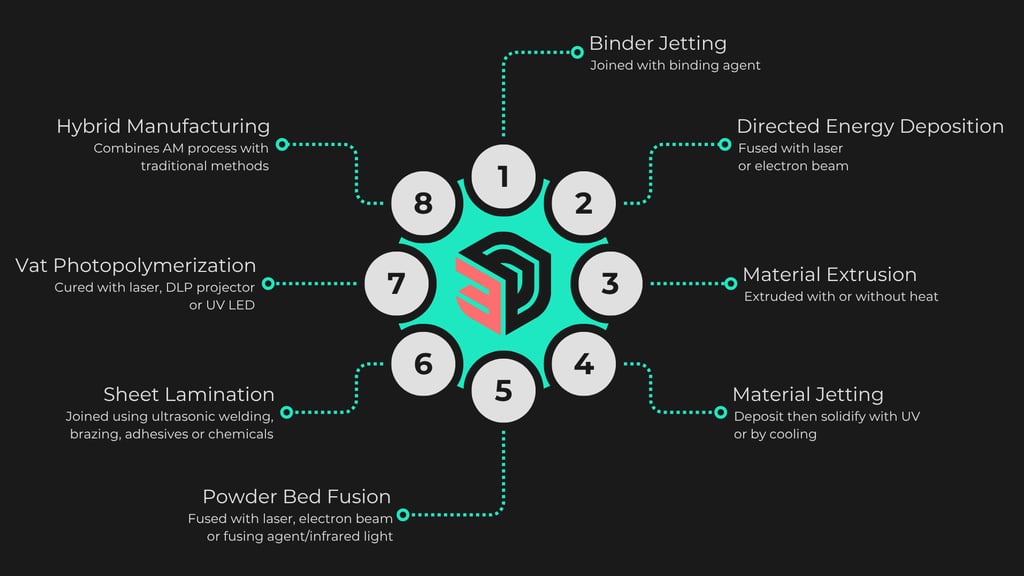Discover the World of Additive Manufacturing: An Intro
Unleash your inner tech nerd and dive into the realm of Additive Manufacturing. This blog post is just the tip of the iceberg on all things AM. Brace yourself for a journey through diverse technologies, materials, and applications that will blow your mind. Stay tuned for more mind-blowing content coming your way soon! 🚀
AMGENERAL
What is Additive Manufacturing?
Additive manufacturing (AM) is similar to building a delicious layer cake, but instead of frosting and sprinkles, it uses layers of material to create a physical object. It all starts with a digital design created using CAD software, then sliced into thin layers like a master chef slicing a cake. These layers are then sent to the AM hardware (3D Printer), which carefully deposits material one layer at a time. Compared to subtractive manufacturing, where material is chiseled away like a sculptor trying to reveal a masterpiece from a block of stone – AM is all about adding layers, not taking them away.


Classes of Additive Manufacturing Processes
The American Society for Testing and Materials (ASTM) has divided additive manufacturing processes into multiple classes, each boasting its own quirks and uses. These methods are anything but cookie-cutter! Stay tuned for upcoming posts where we dive into the nitty-gritty of each class.


Five killer perks of additive manufacturing
# 1. Design Flexibility and Complexity - Who needs a box when you can think outside of it?
With additive manufacturing, you can whip up some seriously intricate designs that would give traditional methods a run for their money. Think internal channels, lattice structures, and all those fancy features without breaking a sweat with extra tooling or assembly.
# 2. Reduced Material Waste - Less Trash, More Cash!
Forget about subtraction, we're all about addition! With additive manufacturing, we're building parts layer by layer, making the most out of every bit of material. This precision in layering materials leads to a whopping 90% reduction in waste compared to subtractive manufacturing methods.
# 3. Rapid Prototyping and Iteration - Inventing on the fly and tweaking endlessly.
Additive manufacturing speeds up the product development process by allowing rapid production of prototypes without the hefty price tag of tooling. Say hello to rapid design tweaks and goodbye to long waits for new products to hit the market! 🚀
# 4. Part Consolidation - Skip the Puzzle, Print the Solution.
Dealing with complex multi-part assemblies? With AM, you can consolidate all those parts into a single, sleek masterpiece. Not only does this simplify manufacturing and assembly, but it also cuts down on the number of components and boosts the performance of the final product. It's like de-cluttering your closet, but for engineering nerds.
# 5. On-Demand and Distributed Manufacturing - on Tap and Everywhere.
With additive manufacturing, you can make parts whenever you need them, saving space and money on excess inventory. Plus, you can produce parts right where you need them, cutting down on shipping costs and wait times.
Behold! The Not-so-Shiny Side of Additive Manufacturing
# 1. High Cost of Entry - The Pricey Admission Ticket.
Purchasing additive manufacturing equipment and technology can break the bank, especially for small businesses. The hefty price tag for necessary equipment is no joke, and many manufacturers have already poured a ton of cash into traditional manufacturing setups.
# 2. Limited Materials - Just a wee bit limited.
Our current selection of materials is a bit, shall we say, lacking compared to what traditional methods offer. And we all know the saying, "limitations can cramp your style." It’s no surprise that this lack of variety could impact the overall quality, durability, and effectiveness of your creations. Just something to think about next time you fire up that 3D printer!
# 3. Slower Production Speeds - Less Than Lightning Fast.
When it comes to churning out a ton of products additive manufacturing might just be the turtle to traditional manufacturing's hare. While a traditional process can whip up a product in the blink of an eye, additive manufacturing may require you to break out the emotional support snacks and settle in for a few hours of fabrication time.
# 4. Surface Quality Issues - Why Can't You Always Be Smooth?
The layering process can sometimes leave you with surfaces that are not as smooth as a baby's bottom. This means you may have to put in some extra elbow grease with post-processing to get that flawless finish you desire. And as they say, time is money, be prepared to fork over a little extra cash for these additional steps.
# 5. Size Limitations - Big Dreams, Small Packages.
Size does matter! Limited by the size of the machine's build chamber, large objects might require fabrication in pieces and assembling later on. Ah, the joys of adding complexity and time to the manufacturing process!
Additive manufacturing is shaking up the production industry with its insane design flexibility, wallet-friendly prototyping, and minimized material waste. Sure, there are a few hurdles to jump over, but the perks of AM are definitely worth the trouble. With technology evolving at lightning speed, AM is gearing up to be the MVP in shaping the manufacturing world!




Why keep all this silliness to yourself? When you share, you show you care